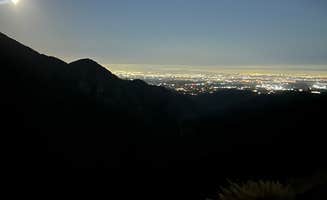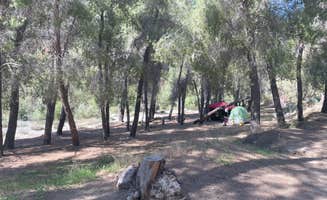Rustic camping near Palos Verdes Estates, California is primarily limited to roadside locations and primitive sites at higher elevations in Angeles National Forest. The steep coastal terrain of the Palos Verdes Peninsula itself offers no legal dispersed camping, requiring visitors to travel 30-45 miles inland to find established options. Most accessible sites lack basic facilities and operate on a first-come basis without reservations.
What to do
Hiking access camping: Heaton Flats serves as a starting point for overnight backcountry trips rather than a destination campground. "I wouldn't feel comfortable setting up a tent here, but it could be an okay rest area at the beginning/end of the hike to Bridge to Nowhere," notes one visitor. The area functions better as a trailhead than a camping destination.
Morning photography: Angeles Crest Overlook to LA provides unobstructed city views for sunrise photography. "The view is gorgeous in the morning sunrise! I'd use it again if I needed it as it's hard to find free places to sleep with a great view like that when traveling through cities," shares one camper. Bring a telephoto lens for distant city shots.
Star observation: Clear nights at higher-elevation pullouts offer stargazing opportunities. "I loved car camping here! When I stayed, there were no other people who stayed the night, but quite a few people came throughout the night just for 20 minutes at a time or so," reports a camper about the relative solitude.
What campers like
Accessibility from urban areas: Hare School Park offers an unconventional overnight parking option closer to the city. "I've been here for a couple days and nobody's mess with us. There's other people that are staying in another parking lot attached that are homeless in their vehicles mostly cars and vans," reports one traveler, indicating unofficial tolerance for overnight stays.
Pet exercise areas: Some locations provide space for pets to stretch their legs. "There is a dog park kind of area with a big field they can run around and just clean up after them," notes a visitor to Hare School Park. This feature compensates for the lack of designated pet facilities.
Weekday solitude: Roadside areas see dramatically different usage patterns throughout the week. "During the week it's more quiet. Close to town so that is a plus," explains a camper, suggesting Monday through Thursday offers the best experience for those seeking quieter stays.
What you should know
Parking lot characteristics: Most sites are not traditional campgrounds. "This is literally just a roadside pull-off. Only really useful in a pinch. No space for a tent. Sleep in your vehicle," clarifies a camper about Angeles Crest Overlook.
Evening traffic patterns: Expect consistent nighttime visitors at popular overlooks. "There were two others in our lot that stayed the night too. That being said, it did seem like maybe a teen hangout or something - cars did flow in and out occasionally through the night until around midnight," reports one overnight visitor.
Cell service limitations: Connectivity varies significantly by location and carrier. "Unfortunately I didn't have any service (Visible/Verizon), so that was a little scary," notes a camper about connectivity issues at higher elevations.
Tips for camping with families
Safety precautions: Vehicle-based camping requires heightened security awareness. "Be careful though there's a white van that teams up with a black truck they tried to break in my car while I was sleeping. It is very dangerous and luckily I carry at all times and have cameras," warns one camper about potential risks at roadside locations.
Noise considerations: Roadside areas experience significant ambient noise. "Some people stood silently admiring the view, while others played loud music. There were also tire tracks on the ground that suggested to me, some young people come here to test their driving skills," explains a visitor to Angeles Crest Overlook.
Trail-adjacent options: Some locations offer quieter alternatives near hiking trails. "There is a pull off before this that was very quiet near a trail and nobody bothered us. If you have dogs I would recommend the trail pull off my dogs really enjoyed the hike," suggests one camper who found a more secluded spot.
Tips from RVers
Size limitations: Most roadside areas accommodate only smaller vehicles. "I'm in a 25 foot Fleetwood RV," notes a visitor at Hare School Park, but most pullouts are better suited to vans and compact RVs under 20 feet.
Leveling challenges: Roadside pullouts rarely offer level parking. Bring leveling blocks and be prepared to adjust positioning to find suitable overnight parking angles.
Trash management: While official facilities are minimal, some areas do provide basic waste disposal. "There are no toilets, campfire sites or shade but good cell service," notes a camper describing the limited amenities available at one roadside location.



